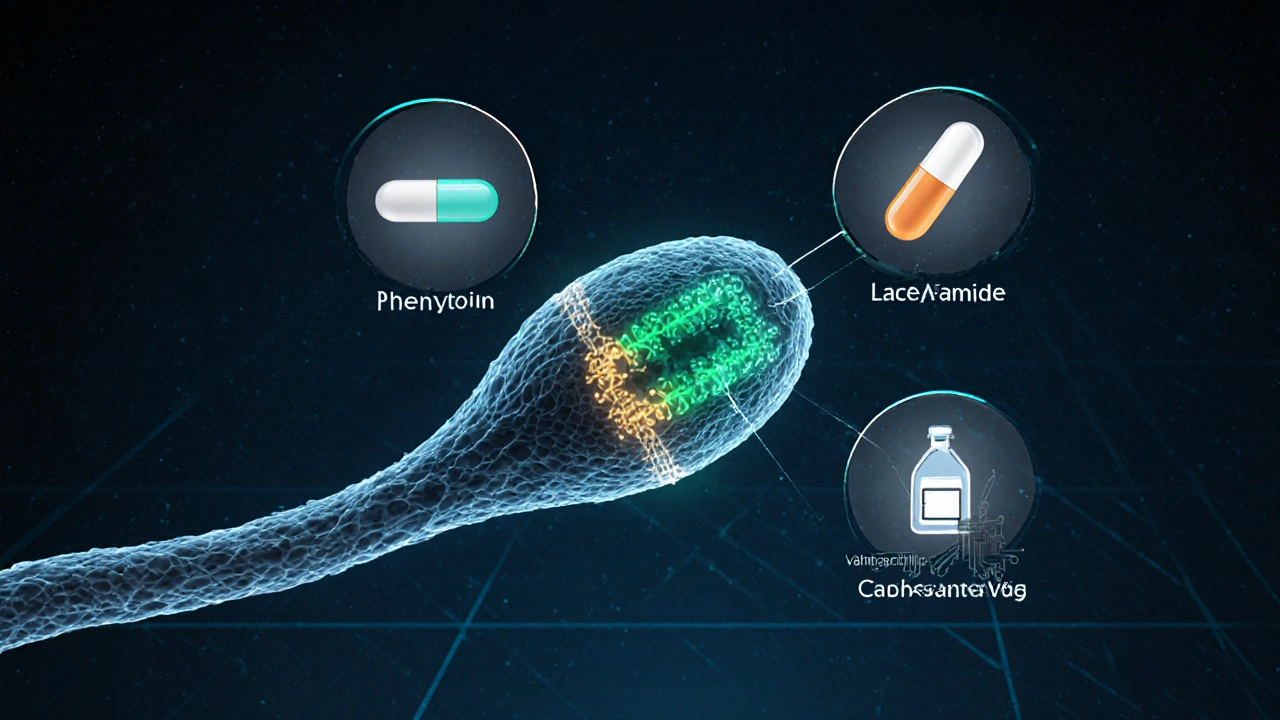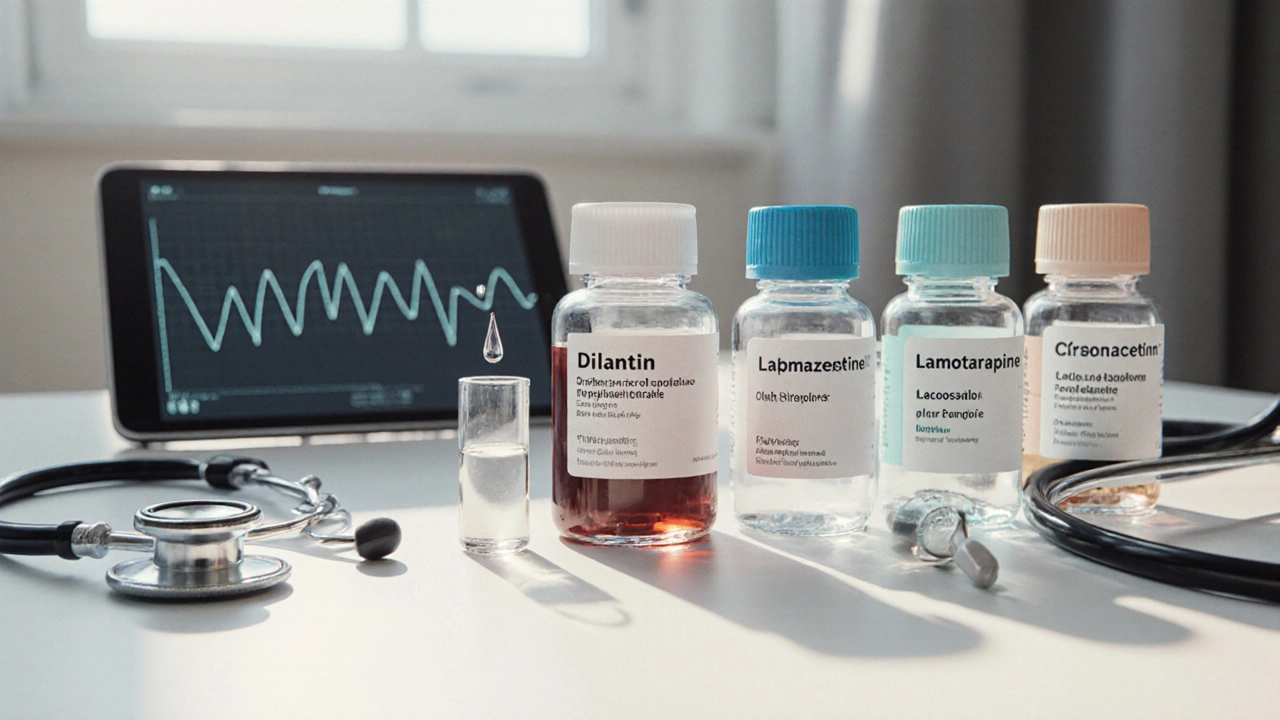Antiepileptic Drug Selector
Find Your Best Dilantin Alternative
Select your key factors to get personalized recommendations based on your specific situation
Your Recommended Alternatives
Important: This tool provides general guidance only. Always consult with your physician before making any medication changes.
Quick Takeaways
- Phenytoin (Dilantin) is effective for many seizure types but requires blood‑level monitoring.
- Levetiracetam, carbamazepine, and lamotrigine are the most common first‑line substitutes.
- Newer agents such as lacosamide and perampanel offer fewer drug interactions.
- Choosing the right drug depends on seizure type, comorbidities, side‑effect tolerance, and lifestyle.
- Switching should be done gradually under medical supervision to avoid breakthrough seizures.
Dilantin alternatives are a hot topic for anyone dealing with epilepsy because the right medication can mean the difference between a stable life and frequent seizures.
What is Dilantin (Phenytoin)?
Phenytoin is a classic anticonvulsant marketed under the brand name Dilantin. It was first approved in the 1930s and works by stabilizing neuronal membranes and reducing the spread of seizure activity through inhibition of voltage‑gated sodium channels. Because it has a narrow therapeutic window, doctors routinely check blood levels to stay within the 10‑20µg/mL range.
Why people consider alternatives
While Phenytoin can control focal and generalized tonic‑clonic seizures, several practical issues push clinicians and patients toward other options:
- Frequent drug‑drug interactions (e.g., with warfarin, oral contraceptives, and many antibiotics).
- Irregular absorption leading to unpredictable serum concentrations.
- Side‑effects such as gum overgrowth, hirsutism, and cerebellar dysfunction.
- Convenient dosing-Phenytoin often requires multiple daily doses.
These drawbacks have spurred the development of newer antiepileptic drugs (AEDs) that are easier to manage.

Key factors when comparing AEDs
Before diving into specific alternatives, it helps to set a decision‑making framework. The most common criteria are:
- Efficacy for the specific seizure type - some drugs excel at focal seizures, others at generalized seizures.
- Side‑effect profile - cognitive impact, skin reactions, weight changes, etc.
- Drug interaction potential - especially important for patients on multiple chronic meds.
- Monitoring requirements - blood‑level checks, liver function tests, etc.
- Dosing convenience - once‑daily vs multiple‑daily dosing, need for titration.
- Cost and insurance coverage - generic drugs vs brand‑only newer agents.
Top alternatives to Dilantin
Below are the most frequently considered substitutes, each introduced with a short definition and core attributes.
Levetiracetam is a broad‑spectrum AED that binds to the synaptic vesicle protein SV2A, modulating neurotransmitter release. It is available in immediate‑release, extended‑release, and injectable forms.
- Typical dose: 500‑1500mg twice daily.
- Indications: Partial seizures, myoclonic seizures, primary generalized tonic‑clonic seizures.
- Side‑effects: Mood changes, fatigue, occasional dizziness.
- Drug interactions: Minimal.
Carbamazepine works by blocking sodium channels similarly to Phenytoin but has a more predictable pharmacokinetic profile.
- Typical dose: 200‑1200mg/day in divided doses.
- Indications: Focal seizures, trigeminal neuralgia.
- Side‑effects: Drowsiness, hyponatremia, rash (rare severe Stevens‑Johnson).
- Drug interactions: Induces CYP3A4, affecting many other meds.
Lamotrigine stabilizes neuronal membranes by inhibiting sodium channels and reduces excitatory glutamate release.
- Typical dose: 25‑200mg daily (slow titration required).
- Indications: Focal seizures, generalized tonic‑clonic seizures, Lennox‑Gastaut syndrome.
- Side‑effects: Skin rash (risk of Stevens‑Johnson syndrome if titrated too quickly), dizziness.
- Drug interactions: Moderate with valproate (increases lamotrigine levels).
Lacosamide enhances slow inactivation of sodium channels, offering a novel mechanism among sodium‑modulating drugs.
- Typical dose: 200‑400mg/day in two doses.
- Indications: Partial seizures (adjunctive).
- Side‑effects: Dizziness, nausea, PR‑interval prolongation.
- Drug interactions: Low.
Valproate (Valproic Acid) increases GABA availability and blocks sodium channels, making it effective for a wide range of seizure types.
- Typical dose: 500‑2000mg/day.
- Indications: Generalized seizures, absence seizures, myoclonic seizures.
- Side‑effects: Weight gain, hair loss, liver toxicity, teratogenicity.
- Drug interactions: Inhibits many CYP enzymes.
Oxcarbazepine is a keto‑analog of carbamazepine with fewer drug interactions.
- Typical dose: 300‑2400mg/day.
- Indications: Focal seizures.
- Side‑effects: Hyponatremia, dizziness.
- Drug interactions: Moderate CYP3A4 induction.
Topiramate blocks sodium channels, enhances GABA, and antagonizes AMPA/kainate receptors.
- Typical dose: 25‑200mg/day.
- Indications: Focal seizures, generalized seizures, migraine prophylaxis.
- Side‑effects: Cognitive slowing, kidney stones, weight loss.
- Drug interactions: Minor.
Side‑by‑side comparison
| Drug | Mechanism | Typical Dose Range | Monitoring Needed? | Common Side‑effects | Drug‑interaction Risk |
|---|---|---|---|---|---|
| Phenytoin (Dilantin) | Na⁺ channel blocker | 100‑300mg daily (divided) | Serum level every 3-6mo | Gingival hyperplasia, hirsutism, ataxia | High (inducer) |
| Levetiracetam | SV2A binding | 500‑1500mg BID | None | Mood changes, fatigue | Low |
| Carbamazepine | Na⁺ channel blocker | 200‑1200mg/day | Liver enzymes, CBC | Drowsiness, hyponatremia | High (CYP3A4 inducer) |
| Lamotrigine | Na⁺ channel blocker | 25‑200mg/day | None (watch rash) | Rash, dizziness | Moderate (valproate ↑ levels) |
| Lacosamide | Slow Na⁺ channel inactivation | 200‑400mg/day | ECG (PR interval) | Dizziness, nausea | Low |
| Valproate | GABA ↑, Na⁺ block | 500‑2000mg/day | Liver function, CBC | Weight gain, hair loss | High (enzyme inhibitor) |
| Oxcarbazepine | Na⁺ channel blocker | 300‑2400mg/day | Sodium levels | Hyponatremia, dizziness | Moderate |
| Topiramate | Multiple mechanisms | 25‑200mg/day | Kidney stones, weight | Cognitive slowing, kidney stones | Low |

Which alternative fits which patient?
Scenario 1 - Young adult on multiple meds (e.g., mood stabilizers, anticoagulants): Levetiracetam shines because it barely interacts with other drugs and needs no blood tests.
Scenario 2 - Patient with focal seizures and a history of hyponatremia: Oxcarbazepine is risky; lamotrigine offers good efficacy with a low hyponatremia profile.
Scenario 3 - Women of child‑bearing age: Avoid valproate due to teratogenicity. Levetiracetam or lamotrigine are safer choices.
Scenario 4 - Need for once‑daily dosing: Lacosamide (once or twice daily) or topiramate extended‑release simplify the regimen.
Scenario 5 - History of severe skin rash: Avoid carbamazepine and lamotrigine; consider levetiracetam or lacosamide.
Practical tips for switching from Dilantin
- Never stop Phenytoin abruptly; taper over 1-2weeks while introducing the new AED.
- Overlap therapy for at least the time needed to reach therapeutic levels of the substitute (often 1week for levetiracetam, 2weeks for lamotrigine).
- Schedule a follow‑up visit to check seizure control and any emerging side‑effects.
- Maintain a seizure diary during the transition period; note dosage times, breakthrough events, and mood changes.
- Inform the pharmacy of the switch so they can adjust refill schedules and avoid accidental dual dispensing.
Common pitfalls and how to avoid them
Switching AEDs is fraught with potential missteps. Here are the most reported issues and quick fixes:
- Under‑titrating new medication - leads to breakthrough seizures. Follow the recommended titration schedule; if seizures recur, increase dose incrementally.
- Ignoring drug-drug interactions - especially with enzyme inducers like carbamazepine. Use an interaction checker or consult a pharmacist.
- Missing blood‑level checks - critical for Phenytoin, valproate, and carbamazepine. Schedule labs before and after the switch.
- Not considering comorbidities - e.g., renal impairment limits topiramate; hepatic disease affects valproate.
Frequently Asked Questions
Can I take Dilantin and levetiracetam together?
Yes, they can be combined when monotherapy fails, but the dose of each must be lowered to reduce side‑effects. Close monitoring for fatigue or mood changes is advised.
Why does Phenytoin cause gum overgrowth?
Phenytoin stimulates fibroblast activity and collagen production in the gums, leading to gingival hyperplasia. Good oral hygiene and regular dental visits can keep it manageable.
Is carbamazepine safe for people with depression?
Carbamazepine can worsen depressive symptoms in some patients. If depression is a concern, alternatives like levetiracetam or lamotrigine, which have neutral mood profiles, are often preferred.
How long does it take for blood levels of Phenytoin to stabilize after a dose change?
Phenytoin’s half‑life varies widely (7-42hours). Generally, steady‑state is reached after 5-7days, so clinicians wait at least a week before re‑checking levels.
Which AED is best for someone with both epilepsy and chronic kidney disease?
Levetiracetam and lamotrigine have minimal renal clearance, making them safer choices. Topiramate and valproate require dose adjustments or close monitoring.


Brooks Gregoria
October 12, 2025 AT 20:18Everyone raves about levetiracetam, but forgetting that its mood‑altering side‑effects can be a nightmare for patients with depression. The drug's lack of interaction is over‑hyped when you consider the rare but severe irritability cases. Phenytoin’s predictable sodium‑channel block still has a place for those who tolerate its monitoring. If you chase a clean pill, you might end up swapping one set of problems for another. Bottom line: don’t let the hype dictate your therapy.
Sumit(Sirin) Vadaviya
October 12, 2025 AT 21:25While the points above are valid, the pharmacokinetic profile of levetiracetam offers practical advantages in polypharmacy contexts 😊.
Minimal hepatic metabolism reduces the risk of enzyme‑mediated interactions, which is especially relevant for patients on anticoagulants.
Moreover, the absence of routine serum level monitoring simplifies outpatient follow‑up.
Clinical guidelines often list it as first‑line for focal seizures when comorbidities are present.
These considerations make it a reasonable alternative for many.
lindsey tran
October 12, 2025 AT 23:13Levetiracetam totally saved my life, like seriously!
Krishna Sirdar
October 13, 2025 AT 01:43When choosing an alternative, consider the seizure type first, then check the side‑effect profile that fits your daily life.
For focal seizures, levetiracetam and lacosamide offer reliable control with low interaction risk.
Generalized seizures often respond well to levetiracetam or lamotrigine, especially for women of child‑bearing age.
Keep in mind any comorbidities such as kidney disease; drugs cleared renally need dose tweaks.
A simple decision tree can guide you toward the most suitable AED.
becca skyy
October 13, 2025 AT 04:13I’ve seen people jump straight to the newest brand without checking if a generic version could do the job. Often the older meds like carbamazepine are affordable and work fine if you monitor labs. Just talk to your doc about what fits your budget and lifestyle.
Theo Roussel
October 13, 2025 AT 07:00From a pharmacodynamic standpoint, levetiracetam’s SV2A binding confers a broad‑spectrum efficacy while maintaining a negligible cytochrome P450 interaction profile, making it pharmacokinetically advantageous in polypharmacy scenarios.
Erick Masese
October 13, 2025 AT 09:46Levetiracetam strikes a nice balance between efficacy and simplicity; you get once or twice daily dosing without the hassle of serum level checks, which many patients appreciate.
Matthew Charlton
October 13, 2025 AT 12:33If you’re nervous about switching, set a realistic timeline: taper phenytoin over ten days, start the new AED at a low dose, and increment weekly. Keep a log of seizure frequency and any new symptoms; sharing that with your neurologist will fine‑tune the regimen.
Pamela may
October 13, 2025 AT 15:20Switching from phenytoin to a newer AED is not a trivial decision and deserves a methodical approach.
First, never abandon phenytoin abruptly; its long half‑life and nonlinear kinetics can precipitate breakthrough seizures if the taper is too rapid.
A typical taper spans one to two weeks while the replacement drug is gradually titrated to its effective dose.
For levetiracetam, the target dose is usually reached within a week, but clinicians often allow an extra few days to monitor mood changes.
Lamotrigine requires a much slower titration-often over several weeks-to avoid the dreaded rash that can evolve into Stevens‑Johnson syndrome.
During the overlap period, maintain a seizure diary, noting seizure frequency, side‑effects, and any mood fluctuations.
Blood‑level checks remain essential for phenytoin until the drug is fully cleared, typically after about five half‑lives.
If the patient has renal impairment, doses of levetiracetam may need modest reduction, whereas lamotrigine is generally safe.
Drug‑drug interactions must be revisited; carbamazepine induces enzymes that could lower levetiracetam levels, while valproate raises lamotrigine concentrations.
Patients on anticoagulants benefit from levetiracetam’s minimal CYP450 impact, reducing the risk of altered warfarin metabolism.
Conversely, those with a history of depression should be warned about levetiracetam’s potential irritability and mood swings.
Educate the patient about the importance of adherence, especially when dosing schedules change from multiple daily doses to once‑daily regimens.
A follow‑up appointment within two weeks after the switch allows the clinician to adjust doses based on clinical response and laboratory results.
If breakthrough seizures occur, consider a brief increase in the new AED’s dose before assuming the switch has failed.
Finally, involve a pharmacist in the transition; they can catch hidden interactions and advise on proper refill timing to prevent accidental dual dispensing.
By observing these steps, the risk of destabilizing seizure control is markedly reduced, and the patient can enjoy a smoother therapeutic journey.
tierra hopkins
October 13, 2025 AT 18:06Side‑effect counseling is key-let patients know that rash with lamotrigine can be serious, so they must report any skin changes immediately.
Ryan Walsh
October 13, 2025 AT 20:53For folks with kidney issues, levetiracetam’s minimal renal clearance makes it a safe pick, but still check the dosing guidelines.
Karl Norton
October 13, 2025 AT 23:40While cost is a factor, cheap generics can hide hidden costs like frequent lab work or hospital visits due to side‑effects; sometimes the pricier newer agents save money in the long run.